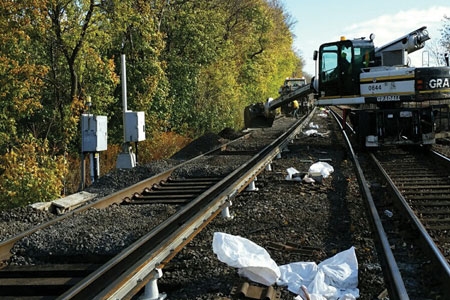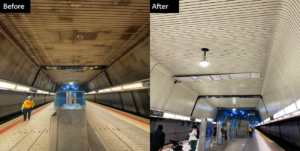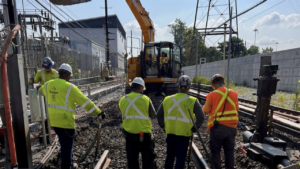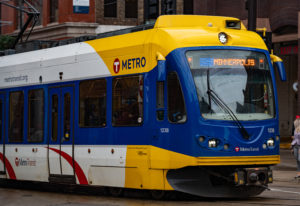Preparing for winter’s return
Written by Mischa Wanek-Libman, editor
MBTA has improved its infrastructure, equipment and operations to ensure service remains reliable, no matter what winter brings.
{besps}January16_winter{/besps}
{besps_c}0|winter1.jpg| MBTA crews worked during the summer to replace ties and strengthen other track elements to prepare for winter weather.{/besps_c}
{besps_c}0|winter2.jpg| Crews perform upgrades to Red Line tracks in preparation for the upcoming winter season.{/besps_c}
MBTA has improved its infrastructure, equipment and operations to ensure service remains reliable, no matter what winter brings.
MBTA has improved its infrastructure, equipment and operations to ensure service remains reliable, no matter what winter brings.The winter of 2014-2015 could be labeled as chaotic at best for the Massachusetts Bay Transportation Authority (MBTA). A quick succession of major storms slammed the Boston area, leaving more than 110 inches of snow. February 2015 was the snowiest month in recorded history for Boston and also the month commuter trains remained on schedule only about a third of the time. A customer confidence crisis ensued, which required quick action and long-term planning to combat.
Massachusetts Governor Charles Baker’s Special Panel to Review the MBTA wrote in a report, “Some have called the winter of 2015 a ‘stress-test’ for the MBTA. While the MBTA ‘survived’ the test, short-term costs were significant in disruption, economic losses and public and private hardship. The long-term costs are even more troubling: the loss of public confidence in our regional transit system.”
As a result of exposed vulnerabilities of the MBTA system, then-General Manager Beverly Scott requested a peer review of the MBTA’s winter preparedness from the American Public Transportation Association. The resulting technical review, along with federal, capital and operating funds, came together to produce the MBTA’s Winter Resiliency Plan. The $83.7-million plan called for investments during the past summer and continuing for the next five years in snow removalequipment, infrastructure upgrades and operations to improve service reliability.
“We learned last winter that in addition to structural reforms, the MBTA needs meaningful improvements to its snow resiliency efforts, including upgrades to infrastructure, operations and equipment,” said MBTA General Manager Frank DePaola.
Funds for the plan consisted of $64 million in federal formula funds for capital investments, $10 million in non-federal, MBTA capital funds and $11.7 million in operating funds.
On the equipment side of the plan, MBTA invested in new and rehabilitated snow removal equipment, as well as vehicle-borne anti-icing equipment, modifications to air and propulsion system resiliency and an increased stock of traction motors. The Red and Orange Lines will see third rail replacements, heater upgrades along outdoor sections and snow fence installation.
Additionally, MBTA plans repairs to vehicle maintenance facilities and structures, the use of emergency power generators to supplement existing subway and facility power and improved track access on the Red Line for larger snow removal and trackwork equipment.
The MBTA says work over the summer and fall included the installation of nearly 70,000 linear feet of new third rail between JFK/UMass Station and Quincy on the Red Line, more than 36,000 linear feet of “Heater Element Infrastructure,” which includes the conduit, wiring and junction boxes to support the Red Line’s third rail heating systems, 200,000 linear feet of new wiring for the Orange Line’s third rail heating system and 5,321 linear feet of snow fencing along Orange Line tracks
To keep the new and existing third rail clear, MBTA bought eight additional third rail anti-icing systems that deploy five to seven gallons of treatment from a vehicle-mounted tote prior to bad weather occurring. MBTA says the system proved effective in preventing ice build-up on the third rail last winter.
While the stockpile of spare traction motors for Red and Orange Line trains is increasing, the MBTA has built 40 new stainless steel plows for trains on those lines with another 40 to be purchased.
The T has also prepared an array of new and refurbished snow-clearing equipment including two jet engine-powered snow blowers, also referred to as “Snowzilla,” capable of producing 3,000 pounds of thrust. Each have been brought into a state of good repair and can be pre-deployed at junctures throughout all of the heavy rail mainlines and yards.
MBTA purchased two new Swingmasters with auger attachments that are capable of throwing snow up to 45 feet in any direction and can be moved over road or rail as needed. Two Viper Jet Snow Blower attachments to be paired with the Swingmasters were also purchased.
The transit authority purchased two auger attachments to be paired with existing ballast regulators, which gives the MBTA some versatility as the machines can throw snow up to 45 feet in any direction, have the ability to change direction on the mainline and can be deployed throughout the heavy and light-rail lines, as well as yards.
On the compact equipment side of things, MBTA bought eight new Compact Track Loaders. MBTA says these machines are the most versatile of the newly-purchased winter resiliency equipment, with heavy-duty rubber tracks for roadway clearing, rail gear for snow-clearing activities on the right-of-way and they can be outfitted with 78-inch or 72-inch auger attachments to provide maximum flexibility in clearing mainline or yard locations.
Finally, for extreme conditions, MBTA turned to a diesel work locomotive and auger that had been idle in the back of a T maintenance yard and brought it into a state of good repair. The 50-ton, shaft driven locomotive can clear a 77-inch wide path.
“The T is not just focusing on physical equipment, but working to improve communications within the organization, as well as with its customers,” said Jason Johnson, MBTA deputy press secretary. “[In December], the T launched its ‘Winter Happens’ campaign to communicate the resources available to its customers in advance of the winter season so that they have access to the most up-do-date service information available.”
MBTA also has a dedicated page on its website that provides real-time information to customers and the Winter Happens campaign is being supported with 86 digital billboards statewide, that are being provided at no cost to MBTA or the Massachusetts Department of Transportation.
“The T has also developed a detailed protocol for responding to emergencies and conducted a Winter Preparedness Tabletop Exercise that brought together multiple departments to review contingencies for various types of emergencies,” said Johnson.
Keolis Commuter Services, which operates the MBTA commuter rail system, is also taking steps to prepare for the harsh conditions of winter including purchasing new snow fighting equipment, creating dedicated snow response teams and centralizing passenger communications in order to keep trains operating safely and to minimize impacts to passengers.
“Our passengers expect and deserve a safe, dependable commuter rail service year-round,” said Keolis General Manager Gerald C. Francis. “We are taking every necessary step to prepare for winter, with the goal of keeping the commuter rail system operating safely and keeping our passengers informed about any changes in service.”





